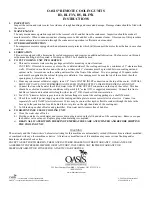
Warnings, Cautions and Notices
Warnings, Cautions and Notices
Note that warnings,
cautions and notices appear at appropriate intervals
throughout this manual. Warnings are provide to alert
installing contractors to potential hazards that could
result in death or personal injury. Cautions are designed
to alert personnel to hazardous situations that could re-
sult in personal injury, while notices indicate a situation
that could result in equipment or property-damage-only
accidents.
Your personal safety and the proper operation of this
machine depend upon the strict observance of these pre-
cautions.
ATTENTION:
Warnings, Cautions and Notices appear
at appropriate sections throughout this literature. Read
these carefully:
D
WARNING
Indicates a potentially hazardous
situation which, if not avoided, could
result in death or serious injury.
D
CAUTION
Indicates a potentially hazardous
situation which, if not avoided, could
result in minor or moderate injury.
It could also be used to alert against
unsafe practices.
D
NOTICE:
Indicates a situation that could result
in equipment or property-damage
only
Important Environmental Concerns!
Scientific research has shown that certain man-made
chemicals can affect the earth’s naturally occurring strato-
spheric ozone layer when released to the atmosphere.
In particular, several of the identified chemicals that may
affect the ozone layer are refrigerants that contain Chlo-
rine, Fluorine and Carbon (CFCs) and those containing
Hydrogen, Chlorine, Fluorine and Carbon (HCFCs). Not
all refrigerants containing these compounds have the
same potential impact to the environment. Trane advo-
cates the responsible handling of all refrigerants-includ-
ing industry replacements for CFCs and HCFCs such as
HFCs.
Responsible Refrigerant Practices!
Trane believes that responsible refrigerant practices are
important to the environment, our customers, and the
air conditioning industry. All technicians who handle
refrigerants must be certified. The Federal Clean Air Act
(Section 608) sets forth the requirements for handling,
reclaiming, recovering and recycling of certain refriger-
ants and the equipment that is used in these service pro-
cedures. In addition, some states or municipalities may
have additional requirements that must also be adhered
to for responsible management of refrigerants. Know the
applicable laws and follow them.
This Installation, Operation, and Maintenance manual
applies to CenTraVac chillers with two different refriger-
ant and oil systems:
•
R-123 and OIL00022
•
R-514A and OIL00334/OIL00335
Important:
Verify proper refigerant and oil for your
chiller before proceeding!
D
WARNING
Proper Field Wiring and Grounding
Required!
All field wiring MUST be performed by qualified per-
sonnel. Improperly installed and grounded field wiring
poses FIRE and ELECTROCUTION hazards. To avoid
these hazards, you MUST follow requirements for field
wiring installation and grounding as described in NEC
and your local/state electrical codes. Failure to follow
code could result in death or serious injury.
Note:
Graphic labels (shown above) are used for CE
application only.
Important:
•
Before servicing, disconnect all power sources and
allow at least 30 minutes for capacitors to discharge.
•
All electrical enclosures—unit or remote—are IP2X.
X39003892001A
2
RELEASED 10/Mar/2020 06:59:20 GMT



































